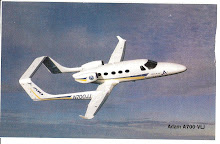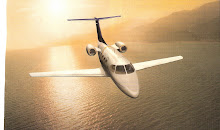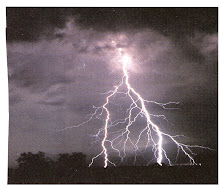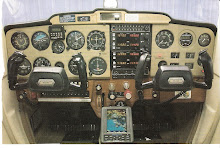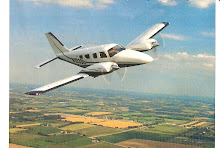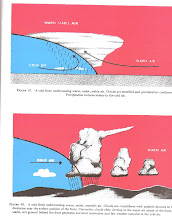Sunday, April 29, 2007
Thursday, April 19, 2007
A Breather
Hold it! Time out for the moment. I digress from aviation thoughts to air a bone of contention, for years, no less, involving the true use of two widely-used phrases used in writing essays, artcles, blogs, etc., even in publications such as Time, U.S. News and World Report. This has been puzzling me for years!
As used by many writers today: 1. Point-of-view, meaning the physical location from which to view.
2.Viewpoint, meaning his or her thoughts on a subject.
Referring to an accepted text on good writing: Writing and Rewriting by Harry Shaw, Jr., the same phrases appear with opposite meaning: 1. Point of view, meaning his or her thoughts on a subject.
2. Viewpoint, meaning the physical location from which to view.
(which makes logical sense to me)
And I will add that Gustave Flaubert, who wrote Madame Bovary back in the 1850's, launching the true Novel, used the phrases correctly, as stated in Harry Shaw's Writing and Rewriting.
What is your view on this? Let's hear what you think!
As used by many writers today: 1. Point-of-view, meaning the physical location from which to view.
2.Viewpoint, meaning his or her thoughts on a subject.
Referring to an accepted text on good writing: Writing and Rewriting by Harry Shaw, Jr., the same phrases appear with opposite meaning: 1. Point of view, meaning his or her thoughts on a subject.
2. Viewpoint, meaning the physical location from which to view.
(which makes logical sense to me)
And I will add that Gustave Flaubert, who wrote Madame Bovary back in the 1850's, launching the true Novel, used the phrases correctly, as stated in Harry Shaw's Writing and Rewriting.
What is your view on this? Let's hear what you think!
Use the checklist !!
USE THE CHECKLIST!
What checklists? Granted there are checklists all over the place in aviation - flight preparation, pre-flight, flight planning, inflight planning, etc.
Right now we are talking to the pilot about flying the airplane.
The manufacturer of the airplane provides the Operating Manual - perhaps called the Flight or Pilot manual- which must be carried in the airplane, along with the Airworthiness Certificate, and other documents, aircraft and Engine logbooks, Squack Sheets, et. There are reasons for these documents to be carried in the airplane: 1. The Operating manual gives us each step of the procedues for operating the airplane, including coping with emergencies, 2. The other documents relate to the airworthiness and the flyable condition of the airplane and its engine. In effect the Operating manual is the checklist, beginning with the Walkaround inspection, engine start, pre-takeoff duties, and operation of each phase of flight (takeoff, climb, cruise, descent, pre-landing and landing -followed by engine shutdown).
Why the checklist? Since we are human beings and subject to human error - mistakes - and at times are forgetful, particularly during excitement and stress. We like excitement; stress we do not want. Stress is an assidious condition that appears automatically when we exhibit uncertain action, untimely acts, and sometimes stupid mistakes. I hate to mention the number of aircraft accidents over the years caused by the pilot's failure to extend the gear prior to landing - gear extention, the most important item on the prelanding checklist.
But let's not think of accidents - rather safe flying.
FAA Part 91 General Operating Flight Rules cover the Private Pilot certificate and VFR (Visual Flight Rules)
Flying, including airplane airworthiness standards, airplane flight manual rquirements, VFR fuel requirements, VFR flight plans, and basic weather minimums - all relating to checklists of one type or another. Let's conclude that the airplane manufacturer has complied with Part 91 in providing the Operating manual for the airplane we are going to fly. It's our best checklist - in the left seat of the airplane. Let's get started. RS.
What checklists? Granted there are checklists all over the place in aviation - flight preparation, pre-flight, flight planning, inflight planning, etc.
Right now we are talking to the pilot about flying the airplane.
The manufacturer of the airplane provides the Operating Manual - perhaps called the Flight or Pilot manual- which must be carried in the airplane, along with the Airworthiness Certificate, and other documents, aircraft and Engine logbooks, Squack Sheets, et. There are reasons for these documents to be carried in the airplane: 1. The Operating manual gives us each step of the procedues for operating the airplane, including coping with emergencies, 2. The other documents relate to the airworthiness and the flyable condition of the airplane and its engine. In effect the Operating manual is the checklist, beginning with the Walkaround inspection, engine start, pre-takeoff duties, and operation of each phase of flight (takeoff, climb, cruise, descent, pre-landing and landing -followed by engine shutdown).
Why the checklist? Since we are human beings and subject to human error - mistakes - and at times are forgetful, particularly during excitement and stress. We like excitement; stress we do not want. Stress is an assidious condition that appears automatically when we exhibit uncertain action, untimely acts, and sometimes stupid mistakes. I hate to mention the number of aircraft accidents over the years caused by the pilot's failure to extend the gear prior to landing - gear extention, the most important item on the prelanding checklist.
But let's not think of accidents - rather safe flying.
FAA Part 91 General Operating Flight Rules cover the Private Pilot certificate and VFR (Visual Flight Rules)
Flying, including airplane airworthiness standards, airplane flight manual rquirements, VFR fuel requirements, VFR flight plans, and basic weather minimums - all relating to checklists of one type or another. Let's conclude that the airplane manufacturer has complied with Part 91 in providing the Operating manual for the airplane we are going to fly. It's our best checklist - in the left seat of the airplane. Let's get started. RS.
Labels:
FAA Regs,
phase of flight,
stress,
VFR flying
Establish A Flying Club?
Establish A Flying Club?
Sure, why not? We'll do it together. Say, call it Robert's Flying Club for now, or if you have a better name, we'll discuss it.
I'm 90 years young now and an old-time pilot, but I'm willing to start over and relearn.
We'll start with Ground School and a small GA airplane, say the Cessna 172, and a small business jet, such as the Eclipse 500.
Then we'll complete the the requirements for a private pilot certificate, take the flight test, and solo. Then a short cross-country flight -only after thoroughly studying the FAA regulations and the Aeronautical Information Manual (AIM). After that, we'll have questions galore - and we'll get the answers.
We'll get into details such as a proper airplane Walkaround Inspection, Preflight Preparation (the key to successful flight), Preflight Weather Briefing, and how to file a Flight Plan.
And then we'll fly some more - and discuss the proper procedures for the actions that we were not so sure of (Some I have to end the sentences with a preposition).
Remember- this is only a start, and we'll cover a multitude of subjects along the way.
If the paperwork gets too heavy, I may have to install a small fee.
Coming on board? Give me a buzz on: roberthshaw@sbcglobal.net.
Sure, why not? We'll do it together. Say, call it Robert's Flying Club for now, or if you have a better name, we'll discuss it.
I'm 90 years young now and an old-time pilot, but I'm willing to start over and relearn.
We'll start with Ground School and a small GA airplane, say the Cessna 172, and a small business jet, such as the Eclipse 500.
Then we'll complete the the requirements for a private pilot certificate, take the flight test, and solo. Then a short cross-country flight -only after thoroughly studying the FAA regulations and the Aeronautical Information Manual (AIM). After that, we'll have questions galore - and we'll get the answers.
We'll get into details such as a proper airplane Walkaround Inspection, Preflight Preparation (the key to successful flight), Preflight Weather Briefing, and how to file a Flight Plan.
And then we'll fly some more - and discuss the proper procedures for the actions that we were not so sure of (Some I have to end the sentences with a preposition).
Remember- this is only a start, and we'll cover a multitude of subjects along the way.
If the paperwork gets too heavy, I may have to install a small fee.
Coming on board? Give me a buzz on: roberthshaw@sbcglobal.net.
Saturday, April 14, 2007
Aviation Today
Aviation is the prime mode of transportation in the U.S. Airline, General Aviation (GA), and Helicopter travel.
In the operational sense, aviation is 629,539 certificated pilots, upwards of 230,000 airplanes in the sky at one time, flying in a patchwork of cluttered airways, controlled by FAA Centers and Towers under instrument and visual flight conditions, performing takeoffs and landings at 5,270 public-use airports.
Some of the GA flying is accomplished without a flight plan, weather briefing, or proper flight preparation.
Many of the smaller airports are being crowded out by regional and local encroachments of expanding populations.
The price of aviation fuel remains “high”, and the grade of fuel is not always available.
Add flight and weather delays, and airplane and airport security to this “mix” – we now have a multitude of problems, and sometimes accidents and incidents.
There are also statutory and regulatory problems which must be solved by Federal and State (and sometimes Local) coordination and agreements.
Overcrowded airways, a mix of airway and direct routes (depending on installed aircraft equipment), congested airport and route Hubs, authority differences between FAA and NTSB on remedial action and flying violations, and military priorities top the current list of problems.
Congressional oversite regarding aviation funding, taxes, and user fees is urgent – necessary to a solid and workable National Aviation Policy.
--RS
In the operational sense, aviation is 629,539 certificated pilots, upwards of 230,000 airplanes in the sky at one time, flying in a patchwork of cluttered airways, controlled by FAA Centers and Towers under instrument and visual flight conditions, performing takeoffs and landings at 5,270 public-use airports.
Some of the GA flying is accomplished without a flight plan, weather briefing, or proper flight preparation.
Many of the smaller airports are being crowded out by regional and local encroachments of expanding populations.
The price of aviation fuel remains “high”, and the grade of fuel is not always available.
Add flight and weather delays, and airplane and airport security to this “mix” – we now have a multitude of problems, and sometimes accidents and incidents.
There are also statutory and regulatory problems which must be solved by Federal and State (and sometimes Local) coordination and agreements.
Overcrowded airways, a mix of airway and direct routes (depending on installed aircraft equipment), congested airport and route Hubs, authority differences between FAA and NTSB on remedial action and flying violations, and military priorities top the current list of problems.
Congressional oversite regarding aviation funding, taxes, and user fees is urgent – necessary to a solid and workable National Aviation Policy.
--RS
My Professional Experience
I thought you would like to know about my professional career.
40 + years – Aviation Accident Investigator; Accident Reconstruction and Failure Analysis; Report Writing; Evaluation and Analysis of Aviation Safety Problems, including Airport Operations; Expert Witness Testimony; Research.
Aviation Consultant since 1976
Civilian and Military Pilot (no longer active)
Retired from NTSB (National Transportation Safety Board)
1942-1945 WWII Troop Carrier Sq. Cmdr., Operations Officer and Pilot Army Air Forces, US and Overseas.
1946-1951 Schools and USAF.
1952-1960 USAF Directorate of Flight Safety Research
1961-1967 Civil Aeronautics Board, Bureau of Safety.
1968-1976 NTSB, Los Angeles.
1976 – Aviation Consultant
1990 - 1993 Member, Santa Barbara County Airport Commission
Published Writer
Aviation Safety Lecturer
--RS
40 + years – Aviation Accident Investigator; Accident Reconstruction and Failure Analysis; Report Writing; Evaluation and Analysis of Aviation Safety Problems, including Airport Operations; Expert Witness Testimony; Research.
Aviation Consultant since 1976
Civilian and Military Pilot (no longer active)
Retired from NTSB (National Transportation Safety Board)
1942-1945 WWII Troop Carrier Sq. Cmdr., Operations Officer and Pilot Army Air Forces, US and Overseas.
1946-1951 Schools and USAF.
1952-1960 USAF Directorate of Flight Safety Research
1961-1967 Civil Aeronautics Board, Bureau of Safety.
1968-1976 NTSB, Los Angeles.
1976 – Aviation Consultant
1990 - 1993 Member, Santa Barbara County Airport Commission
Published Writer
Aviation Safety Lecturer
--RS
4 encounters
Hello pilots, will-be pilots and aviation enthusiasts – along your flight career, think about flight safety because somewhere in your progression from training to regular daily flights you will encounter situations and occurrences (that could have resulted in an accident) – anyway, an occurrence which really “shook you up”.
During a lifetime career in Aviation, I can think of many such occurrences which came out for the best and taught me very valuable lessons in flying.
But I digress. Did you know that most pilots are in deathly fear of (1) meeting another aircraft in flight head-on under instrument conditions, (2) stalling the airplane on takeoff or worse yet losing an engine on takeoff, (3) climbing in a narrow canyon and realizing that the terrain was rising faster than your airplane could climb, (4) coming in the clear, after flying through low scud on final approach and seeing power lines in front of you at night – WOW!
To continue, I can vouch for the existence of all of the above occurrences – I have experienced these encounters myself – to use an old familiar phrase, it scared the hell out of me!
Number (4) occurred during a flight from FT. Wayne, Indiana to Hamilton Field, California on my way overseas in 1942. On the final approach at night coming in to Abilene, Texas under near-instrument and rough-air conditions, I asked the Copilot to turn on the landing lights – he couldn’t find the switches! By the time that I got the lights turned on a group of power lines appeared directly ahead. I yanked on the control column (we ballooned upward over the wires), then I had to correct the descent after passing the lines in order not to overshoot the short runway given me by the Tower – but I made it okay!
Number (3) I have never encountered as a pilot, but I have investigated many such accidents for the Civil Aeronautics Board and the National Transportation Safety Board where such flights failed, usually in unfamiliar mountainous areas.
Number (2), I have experienced twice, losing an engine (twin-engine) on takeoff. On both occasions I got the airplane back in to the airport. I realized afterwards that it was risky – the old rule is land straight ahead rather than risk a stall and crashing.
Number (1), I’ve experienced this one twice during WWII in the Pacific Theater – both were too close. There were no airways or traffic control.
Later I will tell you about my worst encounter in WWII where I almost ran out of fuel. I made the landing in Finschhafen, New Guinea. I think I hold the record for getting the most hours from C-47 aircraft 800-gal. fuel tanks, during and after recovering from a steep spiral over the New Guinea mountains at night. GOD and I were on friendly terms that night!
--RS
During a lifetime career in Aviation, I can think of many such occurrences which came out for the best and taught me very valuable lessons in flying.
But I digress. Did you know that most pilots are in deathly fear of (1) meeting another aircraft in flight head-on under instrument conditions, (2) stalling the airplane on takeoff or worse yet losing an engine on takeoff, (3) climbing in a narrow canyon and realizing that the terrain was rising faster than your airplane could climb, (4) coming in the clear, after flying through low scud on final approach and seeing power lines in front of you at night – WOW!
To continue, I can vouch for the existence of all of the above occurrences – I have experienced these encounters myself – to use an old familiar phrase, it scared the hell out of me!
Number (4) occurred during a flight from FT. Wayne, Indiana to Hamilton Field, California on my way overseas in 1942. On the final approach at night coming in to Abilene, Texas under near-instrument and rough-air conditions, I asked the Copilot to turn on the landing lights – he couldn’t find the switches! By the time that I got the lights turned on a group of power lines appeared directly ahead. I yanked on the control column (we ballooned upward over the wires), then I had to correct the descent after passing the lines in order not to overshoot the short runway given me by the Tower – but I made it okay!
Number (3) I have never encountered as a pilot, but I have investigated many such accidents for the Civil Aeronautics Board and the National Transportation Safety Board where such flights failed, usually in unfamiliar mountainous areas.
Number (2), I have experienced twice, losing an engine (twin-engine) on takeoff. On both occasions I got the airplane back in to the airport. I realized afterwards that it was risky – the old rule is land straight ahead rather than risk a stall and crashing.
Number (1), I’ve experienced this one twice during WWII in the Pacific Theater – both were too close. There were no airways or traffic control.
Later I will tell you about my worst encounter in WWII where I almost ran out of fuel. I made the landing in Finschhafen, New Guinea. I think I hold the record for getting the most hours from C-47 aircraft 800-gal. fuel tanks, during and after recovering from a steep spiral over the New Guinea mountains at night. GOD and I were on friendly terms that night!
--RS
Wednesday, April 4, 2007
Introduction to Robertsflyers
Hello fellow pilots, will-be pilots, and aviation enthusiasts- along your flight career, somewhere between your training and regular solo flights you will encounter situations and occurrences (that could result in an aircraft accident) that will in all probability "shake you up". You must now and from the very beginning think about air safety. What is air safety? Air safety involves airplanes, airspace, takeoffs, landings, weather, flight plans, clearances, pilot proficiency, and a host of other labels.
As a 90-yr old pilot and a retired NTSB aircraft accident investigator(fixed-wing, jets, helicopters, hot-air balloon, etc.) I think I can help you with many of the aviation and flying problems - including FAA definitions and where can I find this or that, or just plain good advice in your flying. Or if you have an accident, I can even help you with that.
My next, and future blogs will take up specific subjects that are hard to learn for pilots - one of them is Use The Checklist. Before I leave, are all of you aware that there is a battle going on regarding "user fees" for General Aviation flying? If you are interested in airplane talk, contact me , or see RobertshawConsulting,com. RS.
As a 90-yr old pilot and a retired NTSB aircraft accident investigator(fixed-wing, jets, helicopters, hot-air balloon, etc.) I think I can help you with many of the aviation and flying problems - including FAA definitions and where can I find this or that, or just plain good advice in your flying. Or if you have an accident, I can even help you with that.
My next, and future blogs will take up specific subjects that are hard to learn for pilots - one of them is Use The Checklist. Before I leave, are all of you aware that there is a battle going on regarding "user fees" for General Aviation flying? If you are interested in airplane talk, contact me , or see RobertshawConsulting,com. RS.
Subscribe to:
Comments (Atom)

